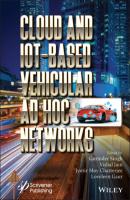Cloud and IoT-Based Vehicular Ad Hoc Networks. Группа авторов
Чтение книги онлайн.

Читать онлайн книгу Cloud and IoT-Based Vehicular Ad Hoc Networks - Группа авторов страница 4
Название: Cloud and IoT-Based Vehicular Ad Hoc Networks
Автор: Группа авторов
Издательство: John Wiley & Sons Limited
Жанр: Автомобили и ПДД
isbn: 9781119761822
isbn:
14 Chapter 15Figure 15.1 Effect of change of TP while varying the packet rate.Figure 15.2 Packet header of route request packet in (a) conventional protocol a...Figure 15.3 Flowchart of the hybrid mechanism.Figure 15.4 TP vs ST for (a) AODV and the (b) PPA-AODV protocols.Figure 15.5 Graph showing the energy levels in the intermediate nodes for Flow I...Figure 15.6 Routing paths of the non-power aware mechanism for Flow ID 1 at the ...Figure 15.7 TP vs NN for (a) AODV and (b) PPA-AODV protocols.Figure 15.8 PDR vs ST for (a) AODV and (b) PPA-AODV protocols.Figure 15.9 PDR vs NN for (a) AODV and (b) PPA-AODV protocols.Figure 15.10 Comparison of the TP of AODV, AOMDV, DSR, DSDV and DYMO protocols w...Figure 15.11 Comparison of the PDR of AODV, AOMDV, DSR, DSDV and DYMO protocols ...Figure 15.12 Comparison of EED of AODV, AOMDV, DSR, DSDV and DYMO protocols with...
15 Chapter 16Figure 16.1 Smart routing model.Figure 16.2 MOA-Fogged Routing (MFR) framework.Figure 16.3 Fog-Simulator (FRM-Framework).Figure 16.4 MOA-Simulator (Classification tool-part1).Figure 16.5 MOA-Simulator (Classification tool-part2).Figure 16.6 MOA-Simulator (Classification tool-part3).Figure 16.7 CloudSim-Simulator (virtual machine with cloudlet-part1).Figure 16.8 CloudSim-Simulator (virtual machine with cloudlet-part2).Figure 16.9 CPU-execution time for one-VM.Figure 16.10 Task’s waiting time for one-VM.Figure 16.11 CPU-execution time for two-VM.Figure 16.12 CPU-waiting time for two-VM.
16 Chapter 17Figure 17.1 Hype cycle showing emerging twelve technologies [9].Figure 17.2 Uses of UAVs in industries to various maturity levels [10].Figure 17.3 Application examples of FANETs.Figure 17.4 Components of UAV communication system [23].Figure 17.5 Types of UAV communication.Figure 17.6 Architecture of UAV-WSN [34].Figure 17.7 The FANET structure.Figure 17.8 The FANET, VANET and MANET structures.Figure 17.9 FANET used for UAV-to-UAV and UAV-to-GCS communication.
List of Tables
1 Chapter 1Table 1.1 Specific examination for various low force Wi-Fi modules [5].Table 1.2 Specific examination for various “IEEE 802.15.4 modules” [5].Table 1.3 Principle contrasts between conventions that might be utilized in IoT ...
2 Chapter 2Table 2.1 Characteristics of service discovery methods.Table 2.2 Comparison of routing unit and service unit.
3 Chapter 4Table 4.1 Vehicle to vehicle wireless access technologies comparison [6, 7].Table 4.2 DSRC channel designation with frequency.Table 4.3 DSRC equipment installation classes.
4 Chapter 6Table 6.1 Relative speed of the vehicle = 0.1.Table 6.2 Relative speed of the vehicle = –0.1.Table 6.3 Relative speed of the vehicle = –0.2.Table 6.4 Relative speed of the vehicle = 0.2.Table 6.5 The heart rate = 40 bpm.Table 6.6 The heart rate = 60 bpm.Table 6.7 The heart rate = 72 bpm.Table 6.8 The heart rate = 92 bpm.
5 Chapter 7Table 7.1 AQI and air pollution scale.Table 7.2 AQI and health hazards.
6 Chapter 9Table 9.1 Security attacks—motivation and contribution.Table 9.2 OpenFlow protocol messages per type.Table 9.3 Main components of flow entry in flow table.Table 9.4 TLS/SSL support by Controllers and Switches from different Vendors.Table 9.5 Simple risk categories.Table 9.6 Summary of Security Comparisons at SDN.Table 9.7 Experimental setting.
7 Chapter 10Table 10.1 Benchmark function.Table 10.2 Mean function values obtained by four methods.Table 10.3 Best function obtained by four methods.
8 Chapter 13Table 13.1 Comparison of ML techniques.Table 13.2 Results of machine learning techniques.
9 Chapter 14Table 14.1 Functions being realized at ECE, SMIT.Table 14.2 Specification of NI SDR USRP 2974.Table 14.3 System comparison.
10 Chapter 15Table 15.1 Flows and their power requirements.Table 15.2 EED for all the flows in AODV and PPA-AODV protocols.Table 15.3 TP comparison of the proposed hybrid protocols with the regular AODV,...Table 15.4 PDR comparison of the proposed hybrid protocols with the regular AODV...Table 15.5 EED comparison of the proposed hybrid protocols with the regular AODV...Table 15.6 TP, PDR and EED with and without the PAM for Flow ID 1 for AODV, AOMD...Table 15.7 TP, PDR and EED with and without the power aware mechanism for Flow I...Table 15.8 TP, PDR and EED with and without the hybrid mechanism for Flow ID 1 f...Table 15.9 Comparison of TP, PDR and EED for AODV, PA-AODV, P-AODV and PPA-AODV ...
11 Chapter 16Table 16.1 Execution time and waiting time for one (1) VM and eight (8) cloudlet...Table 16.2 Execution time and waiting time for two (2) VM and eight (8) cloudlet...
12 Chapter 17Table 17.1 The advantages of a FANET with multiple small UAVs.Table 17.2 Comparison of wireless technologies for UAV communication [31].Table 17.3 A comparison of three ad hoc networks.Table 17.4 Relative market growth of UAVs in various segments.
Guide
1 Cover
5 Preface
8 Index
Pages
1 v